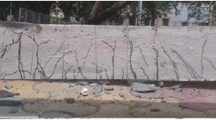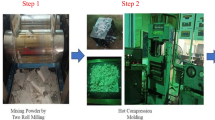Abstract
Failure caused by fretting is the main failure form of orthopedic implants. Two different fiber orientations (0°/90° and 0°/60°) carbon fiber (CF)-reinforced polyetheretherketone (PEEK) composite materials were prepared by the UD laminate method. This study investigates the fretting wear behavior of two different fiber orientations. By changing the normal forces and displacement amplitude, the Ft–D curve, the running condition for the fretting map and the friction coefficient curve are established. Use WLI, SEM and EDS to explore the wear mechanism of CFR-PEEK composite materials. The results show that the two fiber orientations have similar running conditions for the fretting map. And the main wear mechanisms of the two composites are abrasive wear, adhesive wear and oxidative wear. However, the dissipation energy, friction coefficient, wear depth and wear volume of the CFR-PEEK composites with 0°/90° fiber orientation are less than 0°/60° fiber orientation. The CFR-PEEK composites with a fiber orientation of 0°/90° have a better fretting characterization. The experimental results may play a certain guiding role in the field of CFR-PEEK composite medical materials.
















Similar content being viewed by others
References
J.S. Yeom, M.S. Chung, C.K. Lee et al., Evaluation of Pedicle Screw Position on Computerized Tomography Scans, J. Neurosurg., 2003, 98(1), p 104–109.
L. Gjesteby, B.D. Man, Y.N. ** et al., Metal Artifact Reduction in CT: Where Are We After Four Decades?, IEEE Access, 2016, 4, p 5826–5849.
C. Fleck and D. Eifler, Corrosion, Fatigue and Corrosion Fatigue Behaviour of Metal Implant Materials, Especially Titanium Alloys, Int. J. Fatigue, 2010, 32(6), p 929–935.
L. Rony, R. Lancigu and L. Hubert, Intraosseous Metal Implants in Orthopedics: A Review, Morphologie, 2018, 102, p 231–242.
S.Y. Jauch, L.G. Coles, L.V. Ng et al., Low Torque Levels Can Initiate a Removal of the Passivation Layer and Cause Fretting in Modular Hip Stems, Med. Eng. Phys., 2014, 36(9), p 1140–1146.
C.K. Akkan, E.M. Hammadeh, A. May et al., Surface Topography and Wetting Modifications of PEEK for Implant Applications, Lasers. Med. Sci., 2014, 29(5), p 1633–1639.
X.C. Meng, W. Zhang, Z.G. Yuan et al., A Partial Hemi-Resurfacing Preliminary Study of a Novel Magnetic Resonance Imaging Compatible Polyetheretherketone Mini-Prosthesis for Focal Osteochondral Defects, J. Orthop. Transl., 2021, 26, p 67–73.
J.J. Zhu, F. **e and R.S. Dwyer-Joyce, PEEK Composites as Self-Lubricating Bush Materials for Articulating Revolute Pin Joints, Polymers, 2020, 12(3), p 665.
H.D. Xu, D.K. Zhang, K. Chen et al., Taper Fretting Behavior of PEEK Artificial Hip Joint, Tribol. Int., 2019, 137, p 30–38.
G.L. Pan, Q. Guo, W.D. Zhang et al., Fretting Wear Behaviors of Nanometer Al2O3 and SiO2 Reinforced PEEK Composites, Wear, 2009, 266(11), p 1208–1215.
R. Ma and T.T. Tang, Current Strategies to Improve the Bioactivity of PEEK, Int. J. Mol. Sci., 2014, 15(4), p 5426–5445.
M. Regis, A. Lanzutti, P. Bracco et al., Wear Behavior of Medical Grade PEEK and CFR PEEK Under Dry and Bovine Serum Conditions, Wear, 2018, 408–409, p 86–95.
E.L. Steinbergn, E. Rath, A. Shlaifer et al., Carbon Fiber Reinforced PEEK Optima—A Composite Material Biomechanical Properties and Wear/Debris Characteristics of CF-PEEK Composites for Orthopedic Trauma Implants, J. Mech. Behav. Biomed. Mater., 2013, 17, p 221–228.
C.Z. Peng and X.Z. Li, The Mechanical Properties of PEEK/CF Composites Reinforced with ZrO2 Nanoparticles, Mech. Compos. Mater., 2014, 49(6), p 679–684.
Q.F. Wang, Y.X. Wang, H.L. Wang et al., Comparative Study of the Effects of Nano-Sized and micro-sized CF and PTFE on the Thermal and Tribological Properties of PEEK Composites, Polym. Adv. Technol., 2017, 29, p 896–905.
J. Song, Z.H. Liao, H.Y. Shi et al., Fretting Wear Study of PEEK-Based Composites for Bio-Implant Application, Tribol. Lett., 2017, 65(4), p 1–11.
N. Boudeau, D. Liksonov, T. Barriere et al., Composite Based on Polyetheretherketone Reinforced with Carbon Fibres, an Alternative to Conventional Materials for Femoral Implant: Manufacturing Process and Resulting Structural Behavior, Mater. Des., 2012, 40, p 148–156.
M. Sharma, J. Bijwe, E. Mader et al., Strengthening of CF/PEEK Interface to Improve the Tribological Performance in Low Amplitude Oscillating Wear Mode, Wear, 2013, 301(1–2), p 735–739.
C.J. Laux, S.M. Hodel, M. Farshad et al., Carbon Fibre/Polyether Ether Ketone (CF/PEEK) Implants in Orthopaedic Oncology, World. J. Surg. Oncol., 2018, 16(1), p 241–246.
M.S. Kumar, K. Raghavendra, M.A. Venkataswamy et al., Effect of Span Length on Micromechanics of Fracture Under Flexure Load in CFRP Composites, Mech. Adv. Mater. Struct., 2017, 25(9), p 756–765.
D.H. Liu, M.J. Tang and J.H. Yan, Comparative Study of the Tensile Properties of 2D and UD Over-Braided Multilayer Composites, Compos. Sci. Technol., 2021, 210, p 108817. https://doi.org/10.1016/j.compscitech.2021.108817
B. Chen, J.Z. Wang and F.Y. Yan, Comparative Investigation on the Tribological Behaviors of CF/PEEK Composites Under Sea Water Lubrication, Tribol. Int., 2019, 52, p 170–177.
T. **ao, D.S. Wen, S.R. Wang et al., Investigation on Fretting Wear of Al-Li Alloy, Ind. Lubr. Tribol., 2020, 72(7), p 913–921.
R.E. Stanford, A.H. Loefler, P.M. Stanford et al., Multiaxial Pedicle Screw Designs: Static and Dynamic Mechanical Testing, Spine, 2004, 29(4), p p367-375.
X.Q. Pei, L.Y. Lin, A.K. Schlarb et al., Correlation of Friction and Wear Across Length Scales for PEEK Sliding Against Steel, Tribol. Int., 2019, 136, p 462–468.
M. Sharma, M.I. Rao and J. Bijwe, Influence of Fiber Orientation on Abrasive Wear of Unidirectionally Reinforced Carbon Fiber–Polyetherimide Composites, Tribol. Int., 2010, 43, p 959–964.
J. Li, K.F. Zhang and P. Liu, Tribological Behavior and Microstructure of Carbon Fiber– Reinforced Polymer Against Ti6Al4V Alloy in Fretting Contact, Tribol. Trans., 2017, 61(2), p 256–268.
Z. Rasheva, G. Zhang and T. Burkhart, A Correlation Between the Tribological and Mechanical Properties of Short Carbon Fibers Reinforced PEEK Materials with Different Fiber Orientations, Tribol. Int., 2010, 43, p 1430–1437.
L. Rodríguez-Tembleque and M.H. Aliabadi, Numerical Simulation of Fretting Wear in Fiber-Reinforced Composite Materials, Eng. Fract. Mech., 2016, 168, p 13–27.
Acknowledgment
This work was supported by the National Natural Science Foundation of China (No. 51872122), Major Basic Research Projects of Shandong Natural Science Foundation (ZR2020ZD06), the Independent Innovation Team Funding in **an (No. 2019GXRC012), Key projects of Shandong Natural Science Foundation (ZR2020KE062) and Taishan Scholar Engineering Special Funding (No. ts201511040).
Author information
Authors and Affiliations
Corresponding author
Additional information
Publisher's Note
Springer Nature remains neutral with regard to jurisdictional claims in published maps and institutional affiliations.
About this article
Cite this article
Xue, C., Wang, S., Zhang, M. et al. Fretting Characterization of Carbon-Fiber-Reinforced Polyetheretherketone Composites with Different Fiber Orientations. J. of Materi Eng and Perform 31, 4655–4667 (2022). https://doi.org/10.1007/s11665-022-06590-1
Received:
Revised:
Accepted:
Published:
Issue Date:
DOI: https://doi.org/10.1007/s11665-022-06590-1




